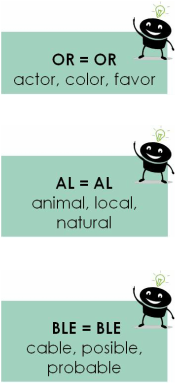Comments
Use the following words and phrases to tell how often you perform an activity. Some of them will already be familiar to you. Veo a mis compañeros de trabajo todos los días. Veo a mis padres una vez por semana. Casi nunca veo a mis abuelos. Y nunca veo a mis tíos que viven en Europa.
Some Spanish words have written accent marks over one of the vowels. That mark is called “acento”. It means that the syllable containing the accent vowel is stressed when the word is pronounced, as in the word “papa”, for example.
Then, the written accent mark is used in the following situations: - All words that are stressed on the third-to-last syllable must have a written accent mark, regardless of which letter they end in. Bo-lí-gra-fo ma-trí-cu-la ma-te-má-ti-cas - When two consecutive vowels do not form a diphthong, the vowel that receives the spoken stress will have a written accent mark. This pattern is very frecuent in words end in –ía Ma-rí-a po-li-cía as-tro-no-mía dí-a bio-lo-gía - Some one-syllable words have accents to distinguish them from other words that spund like them. For example: él (he) / el (the) sí (yes) / si (if) tú (you) / tu (your) mí (me) / mi (my) - Interrogative and exclamatory words have written accent on the stressed vowel. ¿quién? ¿dónde? ¿cuándo? PRÁCTICA: practice what you just learned with the following words, the rules you have learned will help you pronounce them correctly. Don’t worry about the meaning of the words you haven’t heard before! 1. Aquí 2. Práctico 3. Teléfono 4. Sabiduría 5. Papá 6. Murciélago 7. Sociología 8. Mamá 9. Energía 10. Psicología 11. Adiós 12. Jiménez 13. Sánchez For those struggling with ¿qué? and ¿cuál? here there are some guidelines that will help you. Basically, use ¿qué? to mean what? when you are asking for a definition or an explanation. Use ¿cuál? to mean what? in all other circumstances.
Does Spanish speakers perceive things as having female or male attributes? - The gender in Spanish4/27/2015 To name people, places, things, and ideas, you need to use nouns. In Spanish, all nouns (los sustantivos) have either masculine or feminine gender (el género). This is a purely grammatical feature; it does not mean that Spanish speakers perceive things or ideas as having male or female attributes.
Since the gender of all nouns must be memorized, it is best to learn the definite article along with the noun; that is, learn “el libro” rather than just “libro”. The definite article is given in vocabulary lists in many books. We have some easy rules to follow to detect if a noun is femenino o masculino: A. Most of the nouns that ends in –o are masculinos: el libro, el gato, el documento. B. Most of the nouns that ends in –a are femeninos: la casa, la familia, la mesa. C. Most of the nouns that ends in –ión, -tad and –dad are femeninos: la nación, la libertad, la Universidad. D. Many nouns that refer to people indicate gender… a. By changing the last vowel OR b. By adding –a to the last consonant of the masculine form to make it feminine el compañero – la compañera el señor – la señora el profesor – la profesora Like Spanish, many other languages have the concept of gender. For example, French, Italian and Portuguese have both masculine and feminine nouns. In German, nouns can be masculine, feminine, or neuter. English has gender as well (masculine, feminine, and neuter) but it is not as obvious.
 In our last article we reviewed some English words that become Spanish words just changing the syllable to stress. Now let’s boost your Spanish vocabulary even more by just adding a letter at the end of some English words. CATEGORY 4: English words that end in “ic” simply add at the end the letter “o” (ic = ico) público, romántico, tráfico, artístico, elástico, básico, eléctrico, automático, nostálgico, anatómico, didáctico, económico, dramático, botánico, clásico, genérico, atlético, cítrico. TIP: Whenever a letter is accented, stress the letter firmly. Example: roMÁNtico, TRÁfico. CATEGORY 5: Simply add the letter “e” to the end “ent” (ent = ente) cliente, excelente, presidente, conveniente, diferente, inocente, inteligente, inexistente, eficiente, agente. TIP: Stress on the next to the last syllable. Example: presidENte, cliENte. CATEGORY 6: Add the letter “e” to the end “ant” (ant = ante) importante, equivalente, elefante, transparente, antioxidante, restaurante, intolerante, elegante, emigrante, tolerante, instante, distante, implante. TIP: Stress on the next to the last syllable. Example: imporTANte, eleFANte, restauRANte. Incorporating cognates to your conversation is a practically painless way to greatly increase your Spanish knowledge. It sounds too good to be true, doesn’t it? Well, be careful! There are also false cognates that appear to be the same but are not!!! Let’s check some of them in our next article. Did you like the article? Leave a comment: Learn Spanish easily and successfully atTop Language Did you miss part 1 of the article? You can read it here: Painless Spanish: Spanish you don't know you know, boost your Spanish vocabulary in 5 minutes! Part 1 Read the second part of this article:Painless Spanish: Spanish you don't know you know, boost your Spanish vocabulary in 5 minutes! Part 2  It is very easy to build a large vocabulary of Spanish words, even if you are just starting! In fact, you already know thousands of English words that become Spanish words if you change them very slightly. There are a lot of words that are equal or very similar between English and Spanish. There are called cognates and when you see one written, you know right away the meaning of the word, although the pronunciation may be different. You can boost your vocabulary by learning the Spanish pronunciation. Then practice listening for cognates when you here Spanish spoken. Are you ready to boost your Spanish vocabulary in just 5 minutes… or in the time it takes you to read this article? Let’s start, these words fall into several large categories: CATEGORY 1: English words which end in “or” actor = actor doctor = doctor … I think these words don’t need translation; then we have: color, tractor, interior, conductor, error, favor, profesor, inventor, exterior, superior, reflector, inspector, conector, terror, temor, factor, interior. TIP: Sound like a real Pro stressing all these words on the last syllable. An easy rule: Spanish words ending in “or” are stressed on the last syllable. Example: coLOR, docTOR, acTOR. CATEGORY 2: English words which end in “al” animal, electoral, criminal, canal, local, musical, lateral, natural, central, comercial, legal, personal, rural, social, angelical, oficial, elemental, clerical, floral, herbal, usual, total. TIP: Spanish words ending in “al” are stressed on the last syllable too. Examples: aniMAL, soCIAL. CATEGORY 3: English words which end in “ble” cable, noble, horrible, inevitable, accesible, formidable, invisible, probable, honorable, infalible, posible, flexible, visible, terrible, notable, convertible, inseparable, manipulable, censurable, irritable, memorable. TIP: Stress on the next to the last syllable. Example: ineviTAble, acceSIble, CAble, NOble. Did you know these cognates? Incorporating cognates into your conversation is a practically painless way to greatly increase your Spanish. This is not the end of the categories, next week we will publish more of them, in the meantime practice with these words. Want to know more? Learn Spanish easily and successfully at Top Language Spanish at Top Language Did you like the article? Leave a comment: Spanish is one of the Romance languages, like French, Italian, and others, that have developed from Latin. Although there are differences in vocabulary and pronunciation of Spanish as it is spoken in Spain, Latin America, and other parts of the world, what we call Spanish is essentially derived from Castilian, the dialect of historic Spanish region of Castile. As a result, many Spanish speakers refer to the Spanish language as el castellano.
When the Romans invaded the Iberian Peninsula in the second and first centuries B.C., they encountered different peoples with different languages. When these peoples learned Latin form the Roman soldiers, they pronounced the words a little differently, because they continued to use the familiar sounds of their own languages. They retained other important elements of their original languages, especially vocabulary. Other peoples, like those in northern Italy and Gaul (now France), did the same thing. This continued until the “Latin” of different countries evolved into different, though related, languages. Now, while you can guess at words and even forms and rules in a Romance language, based on your knowledge of one of them, a speaker of Spanish cannot be understood by a speaker of French, and vice versa. As in English, Latin words were added to Spanish in the 16th century to form a “learned” language. After the time of the Romans, the Visigoths and other Germanic tribes entered the Peninsula. They were followed by the Arabic-speaking Moors, who invaded Spain in 711 and inhabited most of it until the Reconquest of Spain was complete in 1492, when the Catholic monarchs Ferdinand and Isabella (Fernando e Isabel de Castilla) reclaimed the land. In the same year, Jews and Muslims were expelled from Spanish soil, and Columbus arrived in what would become the Americas. The Moors left a lasting influence on many aspects of Spanish culture, including its architecture, music, and dance; the influence of Arabic on the Spanish language can be seen in words such as algebra, alfombra, and ojalá. The sound system of Spanish continued to evolve in significant ways. Italianisms were introduced during the Renaissance, as they were throughout much of Europe. Spain was strongly influenced by the French monarchy in the 18th century, resulting in overly refined speech that mimicked French. As the Industrial Revolution took hold in the 19th century, Spanish vocabulary adapted to accommodate the changing world. All languages change, and the trend is toward less inflection. Distinctions that seem to be too hard or unnecessary die out. Over the centuries, different languages have eliminated different linguistic elements. For example, in Latin and older languages, every noun had gender, number, and case (which indicated its function in a sentence). In fact, modern German still uses all three grammatical distinctions. In English, we pay little attention to grammatical gender, but nouns still have number (singular and plural) and an additional case (the possessive), while pronouns also have an objective case; the functions of other cases are expressed by word order and prepositions. Spanish has no cases for nouns referring to things, but when referring to persons, the subject is distinguished from the object not only by word order but also by the preposition a, which normally precedes the object noun. Spanish has grammatical gender and number for all nouns. You will notice other instances in which Spanish and English differ. Comparing languages is interesting, because it points out the important elements of each language, but we will leave that chapter for another day. * Taken from the book Side by Side Spanish & English Grammar by Edith & Frederick Farrell. |
AuthorWelcome to Top Language's free learning tools. We want you to enjoy learning Spanish as we love teaching it. Here we share some tips and tools to help you improve your Spanish and to make the process much more fun. ¡Que lo disfrutes! Categories
All
|




 RSS Feed
RSS Feed
